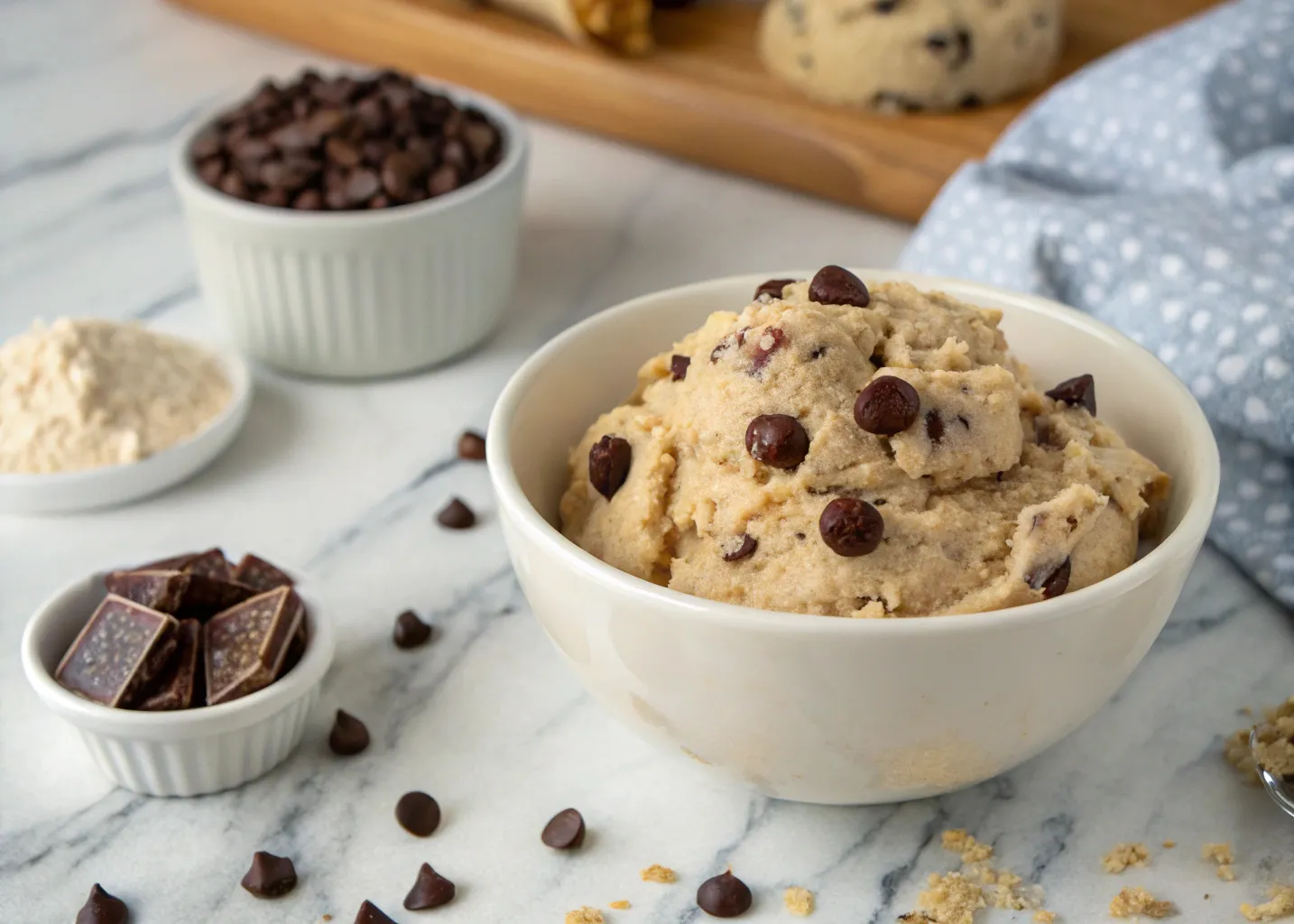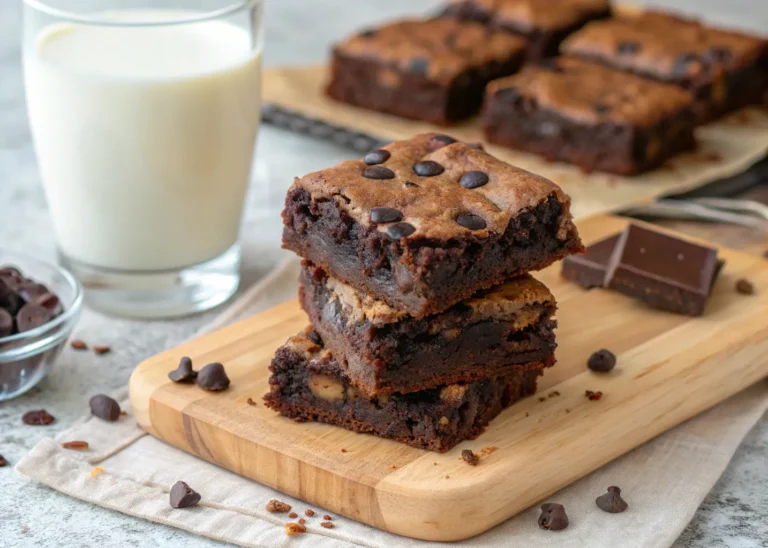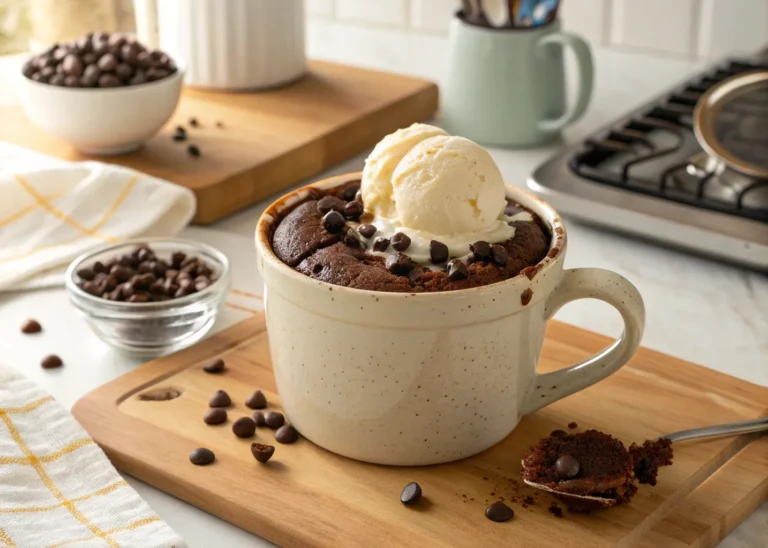If you’ve been scrolling TikTok or Instagram lately, you’ve probably seen a viral trend popping up: cottage cheese cookie dough. And no, it’s not a prank or a fitness influencer gimmick. It’s real, it’s edible, and yes — it tastes amazing.
This high-protein dessert uses cottage cheese as the creamy base to replace heavy ingredients like butter or eggs. That makes it not only lighter and healthier but also gut-friendly and ridiculously easy to make. Even better? You don’t need any protein powder or supplements to make it work.
Want to take it a step further? Learn how to make your own cottage cheese from scratch for an ultra-fresh version of this recipe.
In this article, we’ll break down exactly what this cookie dough is, how it tastes, whether it can be baked, and how to make it with simple ingredients from your kitchen. Whether you’re into clean eating, watching your macros, or just curious — you’re in the right place.
Let’s dive into the delicious details.
What Is Cottage Cheese Cookie Dough and Why It’s Trending
Why Fitness Creators & Health Bloggers Are Obsessed
The rise of high-protein dessert recipes isn’t slowing down — and for good reason. People want treats that satisfy their cravings without wrecking their goals. That’s where cottage cheese cookie dough comes in.
Fitness bloggers love it because it packs slow-digesting casein protein, low sugar, and healthy fats. Meanwhile, clean eaters appreciate that it uses whole, real ingredients — no artificial sweeteners, fillers, or powders needed.
What started as a viral food hack has turned into a legitimate go-to dessert. It’s now being shared across health food communities, Pinterest boards, and even by some registered dietitians.
Not Just a Fad: The Science Behind This High-Protein Treat
Cottage cheese brings two things to the table: texture and nutrition.
First, the creamy texture — when blended — gives you a silky, dough-like base that’s shockingly similar to traditional raw cookie dough. Then comes the nutrition: rich in calcium, high-quality protein, and gut-friendly probiotics (especially if you’re using the live-culture kind).
The result? A dessert that looks indulgent but performs like a post-workout snack.
And no, it won’t taste like cheese.
What Does Cottage Cheese Cookie Dough Taste Like?
Tangy Meets Sweet: A Flavor Combo That Works
Let’s get this out of the way — cottage cheese on its own has a distinct tangy taste. But when you mix it with vanilla extract, natural sweeteners, and a pinch of salt, it blends into something sweet, mellow, and cookie-like.
The natural flavor of cottage cheese disappears once it’s whipped and combined with classic cookie dough add-ins like chocolate chips, oats, nut butter, or cinnamon. Most people say the final flavor is a mix of vanilla frosting and edible dough.
Here’s the best part: you can adjust the sweetness to your taste. Want it richer? Add peanut butter. Want it cleaner? Use maple syrup or dates.
Creamy, Doughy, Delicious: Texture That Feels Indulgent
Texture can make or break a healthy dessert. Luckily, this dough nails it.
When blended, cottage cheese becomes incredibly smooth. Once mixed with flour and other dry ingredients, it transforms into a thick, spoonable dough that’s firm but soft — just like what you’d sneak from a mixing bowl before baking.
Some variations even chill it for 15–30 minutes to create a firmer, scoopable consistency perfect for cookie dough bites or frozen scoops.
This isn’t a dry, chalky “protein dessert.” It’s creamy, lush, and indulgent enough to satisfy your cookie dough cravings — without the sugar crash.
Can You Really Use Cottage Cheese in Cookies?
Yes, and Here’s How It Replaces Butter or Eggs
You might be wondering — how in the world can cottage cheese take the place of classic baking staples like butter or eggs?
It’s simpler than you think.
Cottage cheese adds moisture, fat, and protein, making it an ideal substitute for both butter and eggs in certain cookie recipes. It’s especially effective in recipes that are no-bake, or ones designed to be eaten raw — like edible cookie dough.
In baked cookies, it acts as a moistening agent while still delivering structure, thanks to its mild acidity and curd structure. While it won’t create the exact same crumb or crispiness as butter would, it can result in soft-baked, chewy cookies — and in some cases, even better for those who like dense and fudgy textures.
One tablespoon of blended cottage cheese can substitute one egg or two tablespoons of butter in many healthier recipes. Just make sure you use the blended or whipped version — not curdled or chunky.
Why It Binds & Moistens Better Than You’d Think
Blended cottage cheese is rich in casein protein, a slow-digesting compound that naturally binds ingredients together. That means it can act almost like a glue, helping flours and mix-ins stick without the need for processed emulsifiers or gums.
This is a big deal if you’re working with alternative flours like almond or oat, which don’t bind as well on their own.
Plus, the high moisture content in cottage cheese helps give your dough that soft, pliable feel — even when you’re not baking it. This keeps the texture light, yet doughy, and keeps your dessert from turning into a dry, chalky mess.
In short, cottage cheese works surprisingly well in cookie dough — better than many traditional ingredients in some cases.
No Protein Powder? No Problem
How to Make Cookie Dough with Whole Ingredients Only
You do not need protein powder to make cottage cheese cookie dough. In fact, skipping the powder often leads to better texture and cleaner flavor.
A lot of high-protein desserts rely on powder to bump the numbers, but this recipe gets natural protein from the cottage cheese itself — about 11–13g per ½ cup, depending on the brand.
Here’s a simple ingredient list that skips all supplements:
- Full-fat or low-fat cottage cheese (whipped or blended smooth)
- Natural sweetener (like maple syrup or honey)
- Vanilla extract
- A pinch of salt
- Oat flour or almond flour
- Optional mix-ins: chocolate chips, peanut butter, cinnamon, chopped dates
All clean, natural ingredients. No protein powder required. No artificial aftertaste.
Craving a richer flavor? Try replacing a tablespoon of flour with creamy peanut butter or almond butter. Looking to cut carbs? Opt for almond or coconut flour in smaller amounts for a lighter, low-carb twist.
Looking for a creamy breakfast companion? Try this easy cottage cheese smoothie that’s just as protein-packed and clean.
The result is a cookie dough you can eat by the spoonful — with none of the guilt and all of the goodness.
Clean-Eating Friendly: No Supplements Needed
Let’s talk nutrition for a second.
By using just cottage cheese and real food ingredients, you’re creating a dessert that fits into:
- High-protein diets
- Low sugar meal plans
- Clean eating lifestyles
- Low carb or keto-inspired snacks (with a few tweaks)
It’s naturally low in calories, rich in calcium, and filling enough to keep you satisfied for hours.
Best of all? You don’t have to measure powders or decode weird supplement labels. Just blend, mix, chill, and eat.
Can You Bake with Cottage Cheese?
Yes, and Here’s the Right Way to Do It
So you’ve nailed the no-bake version… but what if you want to bake the dough into actual cookies?
You can — with a few simple rules.
When baking with cottage cheese, blend it smooth first. Any curds left in the mix can lead to separation or inconsistent texture in the oven.
Second, you’ll likely need a little more flour or a dry binder (like oats or flaxseed meal) to account for the moisture. Cottage cheese has a high water content, so adjusting your ratios prevents sogginess.
Here’s a basic rule of thumb:
- For every ½ cup of cottage cheese, add ¾ cup of flour or oat flour
- Bake at 350°F for 10–12 minutes
- Let the cookies cool fully to allow setting
The final result? Soft-baked, protein-rich cookies with a chewy center and lightly crisp edges.
It won’t taste like cheese. It’ll taste like victory.
Pro Tips for Preventing Gritty or Curdled Results
Baking with dairy isn’t always easy, especially when heat comes into play. Here’s how to sidestep common problems:
- Use full-fat cottage cheese for a richer texture
- Blend thoroughly until smooth before mixing
- Avoid overbaking — cottage cheese cookies dry out faster than butter-based ones
- Add moisture-holding ingredients like nut butter, banana, or applesauce if needed
Stick to these steps and your baked cookies will turn out just as satisfying as the raw version.
Can You Use Regular Flour in This Recipe?
All-Purpose vs. Almond vs. Oat Flour – What to Choose
You’re standing in your kitchen, cottage cheese in hand — but the question hits: Can I just use regular flour?
Here’s the answer: Yes, but not raw.
All-purpose flour must be heat-treated before it’s safe to eat in no-bake recipes. Raw flour can contain harmful bacteria like E. coli, so if you’re using AP flour, toast it in the oven at 350°F for 5–7 minutes or microwave it until it reaches 165°F.
However, almond flour and oat flour are often preferred for edible cookie dough since they’re packed with nutrients, safe to eat without baking, and create a softer, more enjoyable texture.
| Flour Type | Safe to Eat Raw | Texture | Flavor Impact | Nutrition |
|---|---|---|---|---|
| All-Purpose | ❌ (Must heat) | Smooth | Neutral | Low fiber |
| Oat Flour | ✅ | Soft | Slightly sweet | High fiber |
| Almond Flour | ✅ | Crumbly | Nutty | Low carb |
How to Adjust Texture & Bake Times with Each Type
- Oat Flour: Soft and chewy. Use a 1:1 swap with regular flour.
- Almond Flour: Slightly grainier. Start with ¾ of the flour amount and add more as needed.
- All-Purpose Flour: Toast it, then use in equal amounts — but you may need a touch more liquid since it absorbs differently.
The bottom line? You can use regular flour, but oat or almond makes your cookie dough healthier and safer — with less effort.
Is Cottage Cheese Cookie Dough Good for You?
Gut Health, Protein Power & Low Sugar Perks
Yes, this cookie dough isn’t just good — it’s gut-friendly, protein-packed, and macro-balanced.
Let’s break it down:
- Protein: Cottage cheese provides 11–14g of slow-digesting casein protein per ½ cup.
- Calcium: One serving covers up to 15% of your daily needs.
- Probiotics: If you use live-culture cottage cheese, you’re also getting beneficial bacteria to support digestive health.
- Low sugar: When sweetened naturally with honey or maple syrup, it stays well under 10g sugar per serving.
It’s a rare win: a dessert that helps you build muscle, balance blood sugar, and support gut function — without giving up dessert.
A Sweet Treat That Doesn’t Spike Your Blood Sugar
Unlike traditional cookie dough packed with refined sugars, this version uses low-glycemic sweeteners and protein to slow the absorption of sugars.
That means fewer energy crashes, steadier moods, and more satisfaction — especially when eaten between meals or post-workout.
And because it’s naturally portion-controlled, you’re more likely to indulge without overdoing it.
The Ultimate Cottage Cheese Cookie Dough Recipe (No Protein Powder)
Ingredients (Pantry & Fridge Staples)
Here’s what you’ll need for 4–6 servings:
- ½ cup full-fat or low-fat cottage cheese (blended smooth)
- 2–3 tbsp maple syrup (or raw honey)
- ½ tsp vanilla extract
- 1 pinch salt
- ⅔ cup oat flour (or almond flour)
- 2 tbsp chocolate chips or chopped dark chocolate
- (Optional: Add 1 tablespoon of peanut butter or almond butter for added richness)
Step-by-Step Directions – Done in Under 10 Minutes

- Blend the cottage cheese until silky smooth (a food processor or mini blender works best).
- Mix in maple syrup, vanilla, and salt until well combined.
- Stir in the flour gradually to avoid clumping. Adjust to desired doughy consistency.
- Fold in chocolate chips or any add-ins.
- Chill in the fridge for 15–30 minutes for best texture.
- Scoop and eat! Store leftovers sealed in the fridge for up to 5 days.
Optional Add-Ins for Flavor: Chocolate Chips, Peanut Butter, More
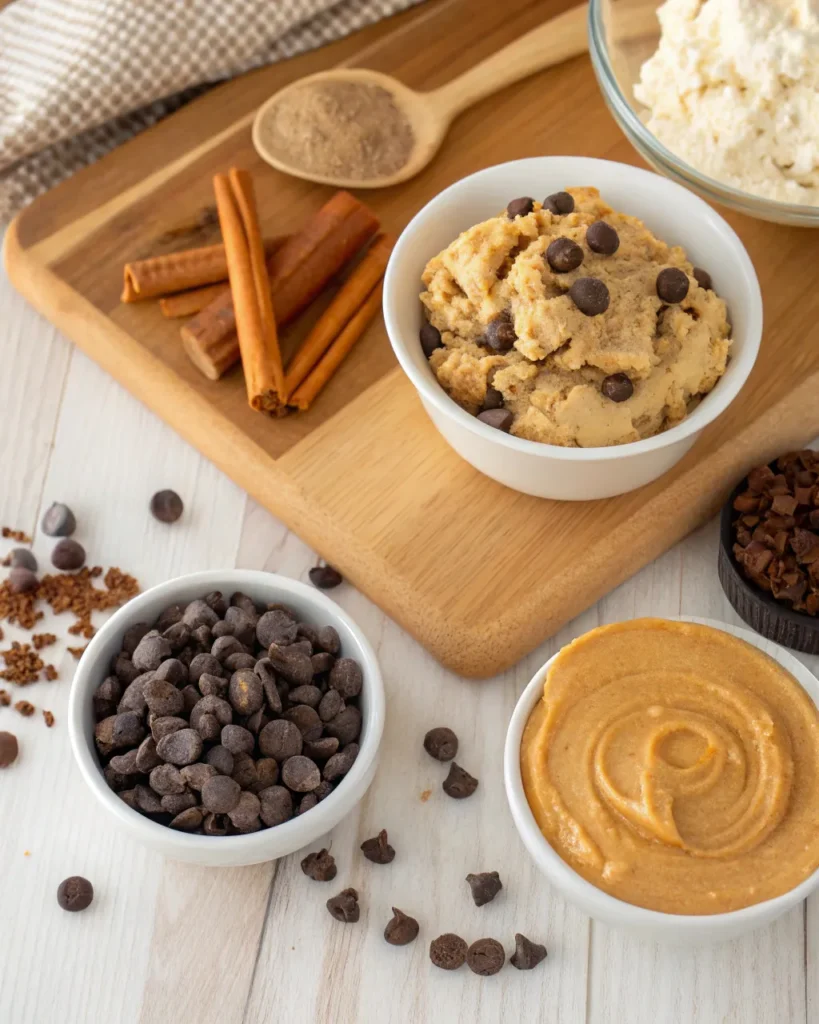
Want to level up the flavor? Here are some clean, tasty ideas:
- Mini dark chocolate chips
- Chopped almonds or walnuts
- A swirl of natural peanut butter
- Dried cranberries or dates
- A dash of cinnamon or pumpkin spice
- A sprinkle of sea salt for that salty-sweet magic
Looking for more cottage cheese creations? These high-protein bagels are soft, chewy, and just as easy to prep.
How to Store It, Eat It, and Not Mess It Up
Fridge, Freezer & Serving Tips for Peak Taste

- Refrigerator: Keep in a sealed container for up to 5 days. The dough firms up a bit—ideal for scooping!
- Freezer: Roll into small balls and freeze. Eat frozen or let thaw slightly for a cookie dough bite.
- Serving: Use it as a spread on toast, dip for apple slices, or filling in a protein sandwich.
This dough is versatile — it’s not just for spooning from the bowl (although that’s encouraged too).
Common Mistakes with Dairy-Based Doughs
Avoid these rookie mistakes:
- Skipping the blending: Always blend cottage cheese to remove lumps and get that creamy base.
- Overloading sweetener: Start with less and add more to taste.
- Using raw AP flour: Toast it first or swap it out altogether.
- Under-chilling: If it’s too soft, a short fridge nap will fix the texture fast.
Done right, this recipe turns into a regular in your snack rotation — one you won’t feel guilty about eating.
FAQs: Cottage Cheese Cookie Dough Questions Answered
Does cottage cheese cookie dough taste good?
Yes — and surprisingly so. When blended and combined with sweeteners and mix-ins like chocolate chips or vanilla, the tang of cottage cheese disappears. What you’re left with is a creamy, rich, and subtly sweet dough that satisfies cookie cravings without the sugar crash.
Can you use cottage cheese to make cookies?
Absolutely. Cottage cheese can replace butter or eggs in cookie recipes. It helps bind ingredients and keeps cookies soft and moist. While it won’t create crispy edges like butter, it delivers excellent texture for soft-baked, chewy results.
Can you make cottage cheese cookie dough without protein powder?
Yes. You don’t need any protein powder at all. Cottage cheese itself is a complete protein source and, when paired with oat or almond flour, makes a protein-rich dough that’s just as filling and satisfying.
Can cottage cheese be used for baking?
Yes, but it needs to be blended for best results. Cottage cheese bakes well in cookies, muffins, and cakes, especially when paired with a stabilizing flour like oats or almond. It adds moisture and a mild tang.
Can you use regular flour in cottage cheese cookie dough?
You can — but you must heat-treat it first. Raw all-purpose flour can carry bacteria. For simplicity and safety, most people use oat or almond flour, which are safe to eat raw and deliver a smoother texture.
Is cottage cheese good for your gut?
Yes. Cottage cheese — especially if labeled with live and active cultures — contains probiotics that support digestion. It’s also low in sugar, high in calcium, and packed with slow-digesting casein protein, making it a gut-friendly snack or dessert.
Conclusion – Why This Is the Best Healthy Cookie Dough You’ll Try
Flavor, Nutrition & Simplicity in One Bite
This isn’t just another health food hack. It’s a genuinely satisfying, protein-rich dessert that tastes good because it uses real, clean ingredients — not despite them.
Cottage cheese cookie dough hits all the right notes: it’s creamy, sweet, safe to eat raw, and customizable to your cravings. You don’t need fancy powders or supplements — just a blender, a few pantry staples, and 10 minutes.
Want the full snack experience? Pair your cookie dough with a refreshing iced matcha latte to keep things balanced and energizing.
So go ahead — make it once, and it might just become your new favorite guilt-free treat.
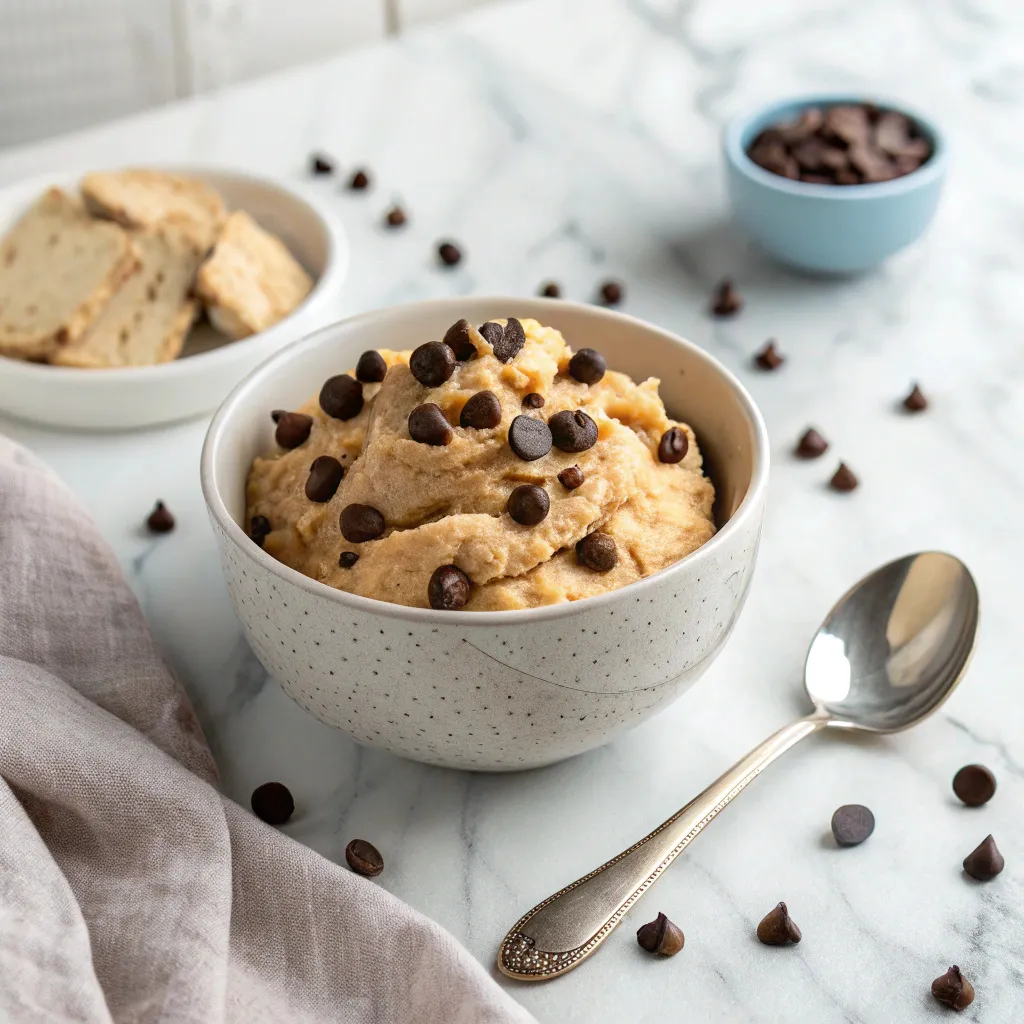
Cottage Cheese Cookie Dough (No Protein Powder)
Ingredients
Equipment
Method
- Add cottage cheese to a blender or food processor. Blend until completely smooth.
- Transfer the blended cottage cheese to a mixing bowl. Stir in maple syrup, vanilla, and a pinch of salt.
- Gradually add the oat flour while stirring until a dough forms.
- Fold in chocolate chips (and peanut butter if using).
- Chill the dough in the fridge for 15–30 minutes to firm up.
- Scoop and enjoy straight from the bowl, or store for later!
Notes
- You can substitute oat flour with almond flour for a lower-carb version.
- For extra flavor, try mixing in cinnamon, chopped nuts, or dried fruit.
- Store in the refrigerator in an airtight container for up to 5 days. The texture firms up nicely, perfect for scooping!
- This dough is also freezer-friendly — roll into bite-sized portions and freeze for a healthy grab-and-go treat.


